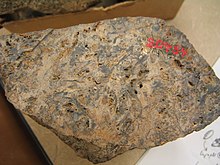| Revision as of 02:31, 7 November 2005 editJpwilson (talk | contribs)28 editsmNo edit summary← Previous edit | Revision as of 03:30, 7 November 2005 edit undo203.12.60.118 (talk)No edit summaryNext edit → | ||
| Line 1: | Line 1: | ||
| '''Paleobotany''' (from the ] words ''paleon'' = old and '' |
'''Paleobotany''' (from the ] words ''paleon'' = old and ''botany'' = plant) is the branch of ] dealing with the recovery and identification of ] remains from ] contexts, and their use in the reconstruction of past environments and the history of life. A closely related field is ], the study of fossil and extant ] and ]. Paleobotany includes the study of ] ] as well as the study of marine ], such as ]. | ||
| Paleobotany is important in the reconstruction of prehistoric ecological systems and ], known as ] and ] respectively, and is fundamental to the study of plant ] and ]. Paleobotany has also become important to the field of ], primarily for the use of ] in ] and in paleo], | Paleobotany is important in the reconstruction of prehistoric ecological systems and ], known as ] and ] respectively, and is fundamental to the study of plant ] and ]. Paleobotany has also become important to the field of ], primarily for the use of ] in ] and in paleo], | ||
Revision as of 03:30, 7 November 2005
Paleobotany (from the Greek words paleon = old and botany = plant) is the branch of paleontology dealing with the recovery and identification of plant remains from geological contexts, and their use in the reconstruction of past environments and the history of life. A closely related field is palynology, the study of fossil and extant spores and pollen. Paleobotany includes the study of terrestrial plant fossils as well as the study of marine autotrophs, such as algae.
Paleobotany is important in the reconstruction of prehistoric ecological systems and climate, known as paleoecology and paleoclimatology respectively, and is fundamental to the study of plant development and evolution. Paleobotany has also become important to the field of archaeology, primarily for the use of phytoliths in relative dating and in paleoethnobotany,
Overview of the Paleobotanical Record
Macroscopic remains of true vascular plants are first found in the fossil record during the Silurian Period. Some dispersed, fragmentary fossils of disputed affinity, primarily spores and cuticles, have been found in rocks from the Ordovician Period of Oman and are thought to derive from liverwort- or moss-grade fossil plants (Wellman et. al., 2003).
An important early land plant fossil locality is the Rhynie Chert, an Early Devonian sinter (hot spring) deposit composed primarily of silica found outside the town of Rhynie in Scotland.

The Rhynie Chert is exceptional due to its preservation of several different clades of plants, from mosses and lycopods to more unusual, problematic forms. Many fossil animals, including arthropods and arachnids, are also found in the Rhynie Chert, and it offers a unique window on the history of early terrestrial life.
Plant-derived macrofossils become abundant in the Late Devonian and include tree trunks, fronds, and roots. The earliest tree is Archaeopteris, which bears simple, fern-like leaves spirally arranged on branches atop a conifer-like trunk (Meyer-Berthaud et. al., 1999).
Widespread coal swamp deposits across North America and Europe during the Carboniferous Period contain a wealth of fossils containing arborescent lycopods up to 30 meters tall, abundant seed plants, such as conifers and seed ferns, and countless smaller, herbaceous plants.
Angiosperms (flowering plants) evolved during the Mesozoic, and flowering plant pollen and leaves first appear during the Early Cretaceous, approximately 130 million years ago.
Notable Paleobotanists
- Kaspar Maria von Sternberg, the "father of paleobotany".
Paleobotany Textbooks
Stewart, W.N. and Rothwell, G.W. 1993. Paleobotany and the evolution of plants, Second edition. Cambridge University Press, Cambridge, UK. ISBN 0-521-38294-7
Taylor, T. N. and E. L. Taylor. 1993. The Biology and Evolution of Fossil Plants, Prentice-Hall, Inc., Englewood Cliffs, New Jersey, USA. ISBN 0-13-651589-4
External links
- Paleobotany Research Group, University Münster, Germany.
- The Biota of Early Terrestrial Ecosystems: The Rhynie Chert, University of Aberdeen, UK.
- The Sternberg Project
References
- Brigitte Meyer-Berthaud, S.E. Scheckler, J. Wendt, "Archaeopteris is the Earliest Modern Tree." Nature, 398, 700-701 (22 April 1999) | doi:10.1038/19516
- Charles H. Wellman, Peter L. Osterloff and Uzma Mohiuddin, "Fragments of the Earliest Land Plants." Nature, 425, 282-285 (18 September 2003) | doi: 10.1038/nature01884